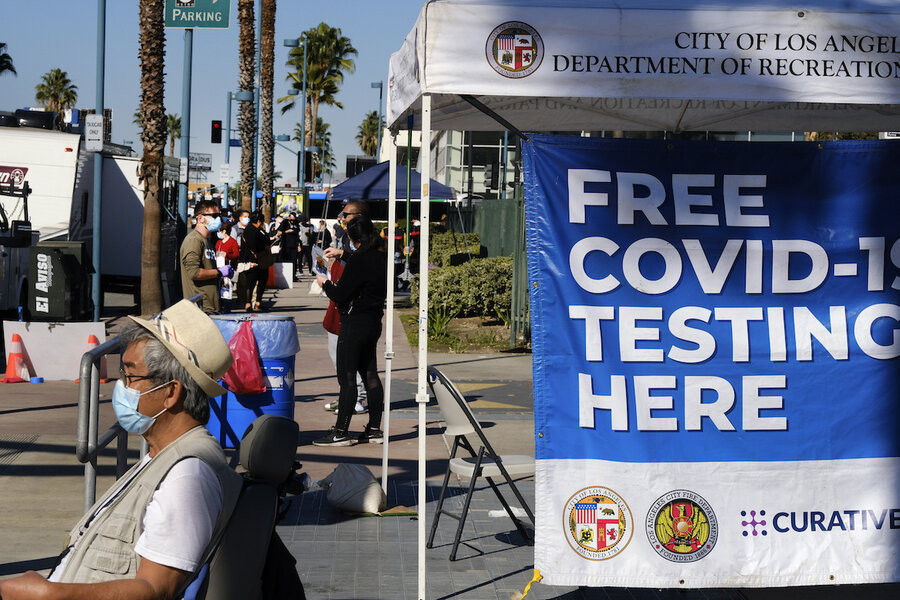Tough lockdown measures in California expose leadership divides
Loading...
| Los Angeles
California compelled much of the state to close shop and stay at home on Monday, when some of the harshest coronavirus restrictions in the United States came into effect one day after the state set a record with more than 30,000 new COVID-19 cases.
Gov. Gavin Newsom’s order was triggered in areas where fewer than 15% of intensive care hospital beds were available, affecting more than 23 million people in Southern California.
In addition, five counties in Northern California surrounding the San Francisco Bay area have voluntarily imposed the restrictions even before reaching the ICU threshold.
California has been under a stay-at-home order for all but essential services since March. The new order, which will last at least three weeks, bans private gatherings of any size, shuts all but critical infrastructure and retail operations, and requires everyone to wear a mask and maintain physical distancing.
Gov. Newsom, a first-term Democrat, has threatened to withhold funds from local governments that refuse to comply.
But the sheriffs of Los Angeles, Orange, and Riverside counties have said they will refuse to enforce the order, emboldening non-essential businesses to remain open.
Riverside County Sheriff Chad Bianco said in a videotaped message posted on the department’s website that his office “will not be blackmailed, bullied, or used as muscle” to enforce the governor’s orders.
“Orange County Sheriff’s deputies will not be dispatched to, or respond to, calls for service to enforce compliance with face coverings, social gatherings or stay at home orders,” his counterpart in Orange County, Don Barnes, said in a written statement.
Even so, the mayor of one Los Angeles County town said more enforcement was needed.
“People absolutely should be arrested for not wearing masks,” Lancaster Mayor R. Rex Perris told the Orange County Register. “Most of these people have never been arrested before. Spend one night incarcerated and they won’t do it again.”
California reported more than 30,000 new cases on Sunday, exceeding the state’s previous high of 21,986 set on Dec. 4, and marked a new record for hospitalized COVID-19 patients.
New Jersey, North Carolina, Virginia, and West Virginia also announced record one-day rises in new infections.
Nationwide, COVID-19 infections in U.S. are at their peak with an average of 193,863 new cases reported each day over the past week, according to a Reuters tally of official data.
There have been 14.7 million infections and 282,253 coronavirus-related deaths reported in the country since the pandemic began.
States are grappling with how to respond to the global pandemic in the absence of a national strategy.
Departing President Donald Trump, a Republican, has downplayed public health measures such as mask-wearing, instead banking on the rapid development of vaccines, which could receive federal approval this month.
President-elect Joe Biden, a Democrat, has said he will make the pandemic his top priority upon taking office on Jan. 20.
One of the president’s own aides on Sunday criticized leaders who have undermined the prevailing medical science.
Dr. Deborah Birx, the White House’s coronavirus response coordinator, has come under fire for failing to speak out against the country’s shortcomings on the pandemic. But she told the NBC News program “Meet the Press” on Sunday that it was “frustrating” to see governors and mayors give up on measures that proved effective in slowing the virus in the spring.
“I hear community members parroting back those situations, parroting back that masks don’t work, parroting back that we should work towards herd immunity, parroting back that gatherings don’t result in super-spreading events,” Dr. Birx said.
Attempting to set the record straight, she said, “You cannot gather without masks in any indoor or close outdoor situation.”
Editor’s note: As a public service, the Monitor has removed the paywall for all our coronavirus coverage. It’s free.
This story was reported by Reuters. Lisa Shumaker, Barbara Goldberg, and Daniel Trotta contributed to this report.





